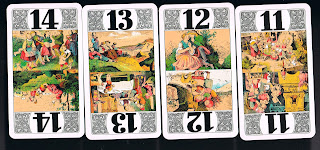" 中國象棋 " ( Chinese chess set) , 32 pieces, butterfly brand.
This set is a typical example of the Chinese chess, or xiangqi set. Despite chess and xiangqi having evolved from the same ancestor, or so we are told, the sets are very different
the pieces are as follows. :.
Red pieces 兵 , 炮 , 車 , 馬 , 相 ,士 , 帥
black pieces 卒 , 炮 , 車 , 馬 , 象 , 士 , 將
Equivellant in chess pawn , ( none) , Rook , Knight, Bishop, ( none), King
Note the fact that equivilant ranks are written differently for the opposing sides
Some pieces, like the 炮 ( cannon) and 士( valet) have no equivalent on chess. The cannon is a most perculiar piece. It can only make a capture, when there is a piece in between it and the target . The cannon has to "jump" over a piece , so to speak. The Valets are another curious piece. They perform a function somewhat similar to the bishops in chess, moving diagonally within the confines of the "square" in the back of the board.
As can be clearly seen from the above diagram, the pieces are made of roundels of wood, on which are engraved the characters. The characters are then coloured in with paint. The colours used are, in this case, red & black, although I have seen green replace black in some sets.
the pieces laid out on the board
Chess sets such as this one come in plastic cases, which are in the form of a rectangle with 2 semicircles attached to the short edges. They are almost invariably supplied with a chessboard, printed on a thin plastic, much like the sort plastic bags are made of. In some of the older sets, we find that they are made of paper.
































